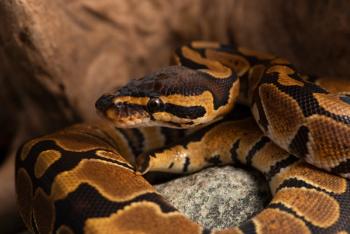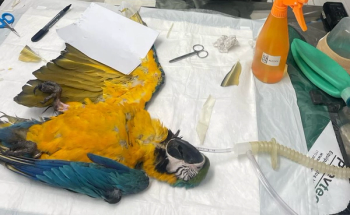
Veterinary management of the small avian patient (Proceedings)
Providing veterinary care to small avian patients can be a tremendous challenge. Basic procedures we take for granted in larger patients can be all but impossible to accomplish in these diminutive, and sometimes quite fragile, animals.
Providing veterinary care to small avian patients can be a tremendous challenge. Basic procedures we take for granted in larger patients can be all but impossible to accomplish in these diminutive, and sometimes quite fragile, animals. The challenge is to minimize the negative impact on the bird, and maximize the amount of information you can get from diagnostic testing. By paying attention to just a few points, the veterinary clinician can drastically improve their ability to work with birds that fall into this size category.
Handling
The person handling the bird is charged with making sure the bird is securely and safely restrained as well as monitoring the animal's condition. There are many techniques for handling birds and none are necessarily better than others as long as the bird can freely breathe and enough of its body is exposed for an adequate examination. The author prefers to hold the bird while performing an exam, as too many fingers in the way can make examination difficult. A good handler will continuously monitor the bird's condition and should be comfortable stopping a procedure if the bird seems to be weakening losing consciousness. If either of these situations occur, it is usually best to abort the procedure and immediately get the bird out of hand into a dark, secure, preferably oxygenated container. Most small birds that "fade" while being held will recover quickly if released, but it's important to watch and be prepared to employ emergency measures if the recovery does not occur within a few seconds.
If a bird happens to escape prior to or during an examination and exerts itself significantly during recapture, it is usually best to allow the bird to rest and recover prior to putting it through the rigors of an exam. By allowing just 10-15 minutes of rest in a secure environment, many undue complications can be avoided.
Examination
The examination starts before the bird is in hand. It is important to gain as much information as possible before catching the bird. It is worthwhile to try to be as unobtrusive as possible when observing the bird in its exhibit, cage, carrier, etc. Direct staring for long periods of time can be incredibly stressful for the target of the attention. As silly as it may sound, it is best to use your peripheral vision to observe captive birds prior to capture.
The longer a bird is in hand, the higher the probability of complications. A complete examination, including venipuncture should never take more than 5 minutes if the clinician is well-prepared. All of the items that may be needed during the exam should be laid out ahead of time and the exam performed in a logical, step-wise fashion. Basic tools the author commonly uses during examination of a tiny bird include a neonatal stethoscope (though placing the bird's breast against your ear works well in a pinch), an ophthalmoscope and transilluminator, and wooden-handled cotton-tipped applicators.
In our practice we work with such a large number of very small birds, we carry a small bird emergency kit with us whenever we are working with avian patients. It consists of a tackle-box filled with emergency drugs, small needles and syringes, bandaging materials, silver nitrate, endotracheal tubes, a few basic surgical instruments, etc. The box is fitted with adaptors so in an emergency it can quickly be dumped out, hooked to an oxygen tank and turned into an oxygen tank. In the few instances we have needed to use it, the setup has performed quite well.
Venipuncture
One of the procedures that gives veterinarians the greatest amount of grief with small birds may be venipuncture. It really is quite easy to kill a small bird via venipuncture, so it is important to have good technique in this procedure. The first step is selection of an appropriately sized needle and syringe. The author uses 27 gauge needles for venipuncture in almost ALL birds. A needle this size induces little trauma to the blood vessel and I have had no problems whatsoever with sample quality. A one or three ml syringe can be used, though with the larger syringe one needs to avoid applying too much vacuum and collapsing the vessel.
The risk of significant hemorrhage associated with venipuncture in small bird is very real. The first trick that helps curtail the incidence of unnecessary hemorrhage is to avoid complete occlusion of the jugular vein when making it rise prior to venipuncture. If the vein is completely occluded and the pressure is high where the puncture is made, there is a tendency for the vessel to "blow" and form a hematoma. Partial occlusion of the jugular vein with raise it just enough for access, but should keep the vessel from blowing.
The second trick it to try and make your venipuncture site as close to the middle of the neck as possible so you can effectively hold it off following blood collection. If the puncture is made too close to the thoracic inlet, hemorrhage from the venipuncture site into the fascial planes of the cranial coelom can occur.
Many avian clinicians use alcohol to part the feathers around the lateral cervical apterium in order to facilitate access to the jugular vein. With small birds it is important to remember that ethanol toxicosis is possible if too much is applied in this manner. The author uses alcohol sparingly in small birds, or simply uses water in especially fragile and rare species.
Careful handling of blood after collection is paramount. There is nothing worse than carefully obtaining a good quality blood sample from a 20 gram bird only to have the majority of it end up on the countertop due to sloppy processing. Wastage of blood is most likely to occur during the production of blood smears. The author recommends using a microhematocrit tube to transfer small drops of whole blood onto the slides. In order to avoid further wastage of the blood sample by transferring from syringe to the anticoagulant tube, some clinicians pre-heparinize their needles and syringes. This is a good way to avoid the frustrations of clotted samples as well. However, some labs (including the author's), feel the heparin drastically affects the quality of the blood smears, making reading the differential difficult. A way to mitigate these changes is to simply make the blood smears quickly following collection as this will minimize the heparin-induced artifact.
Anesthesia
Common sense tells us that the smaller the animal, the more problems they have maintaining a stable body temperature under anesthesia. Despite the wonderful insulation provided by the plumage, a small bird can become dangerously cold in a very short time under anesthesia. It is important to actually monitor body temperature during anesthetic episodes that last more than just a few minutes, as overheating can occur quickly if placed on a heating pad.
Another tip, that may seem a bit counterintuitive, is that the author rarely intubates birds less than 50 g unless absolutely necessary. The reason is that the small endotracheal tubes required by birds of this size often kink or occlude with mucous which make them almost more dangerous than helpful at times. In most cases, a mask can be fashioned out of a syringe case and exam glove which will form a tight enough seal to allow positive pressure ventilation.
Radiography
With tiny birds, it can sometimes be difficult to visualize lesions that one would expect to be painfully obvious, such as long bone fractures and luxations. Old mammography equipment is excellent for producing high quality, magnified radiographic images of small structures. Some of the new digital systems have viewing programs that allow manipulation and magnification of images, making the interpretation of radiographs from small birds somewhat easier. If visualization of internal organs is important, following a plain survey film, the author usually jumps directly to films with GI contrast in order to better define the internal organs. These films are frequently obtained with the birds awake and perching in a small, narrow box which limits their movements. A horizontal beam is used to obtain the lateral image.
Drug Administration
It is rare to find a commercially available drug in a concentration that allows for dosing of small avian patients without dilution. Therefore the clinician needs to become adept at creating dilutions accurately for dosing these birds. Micropipettes and tuberculin syringes are necessary to ensure accurate dosing, even with properly diluted drugs. All doses should be double-checked as gigantic overdoses can occur easily with such small patients.
When diluting drugs for injection, or creating suspensions for oral administration, the author recommends seeking support from a compounding pharmacy. Unless specific information is available for a particular concoction, the characteristics of the drug including bioavailability, and shelf life are unknown. For that reason, the author recommends that a new dose is made immediately before administration to at least avoid problems with shortened shelf-life.
To avoid the damage that undoubtedly occurs when a relatively large amount of drug is injected into the muscle of a small bird; the author gives the vast majority of parenteral medications via the subcutaneous route. If the drug is known to be especially caustic, such as enrofloxacin, it is diluted in physiologic fluids at a ratio of at least 1:10 and given subcutaneously. Very few complications have been experienced using this approach.
In conclusion, by utilizing the recommended tips in conjunction with a logical diagnostic investigation, the clinician can enjoy increased success in management of diminutive avian patients.
Newsletter
From exam room tips to practice management insights, get trusted veterinary news delivered straight to your inbox—subscribe to dvm360.






